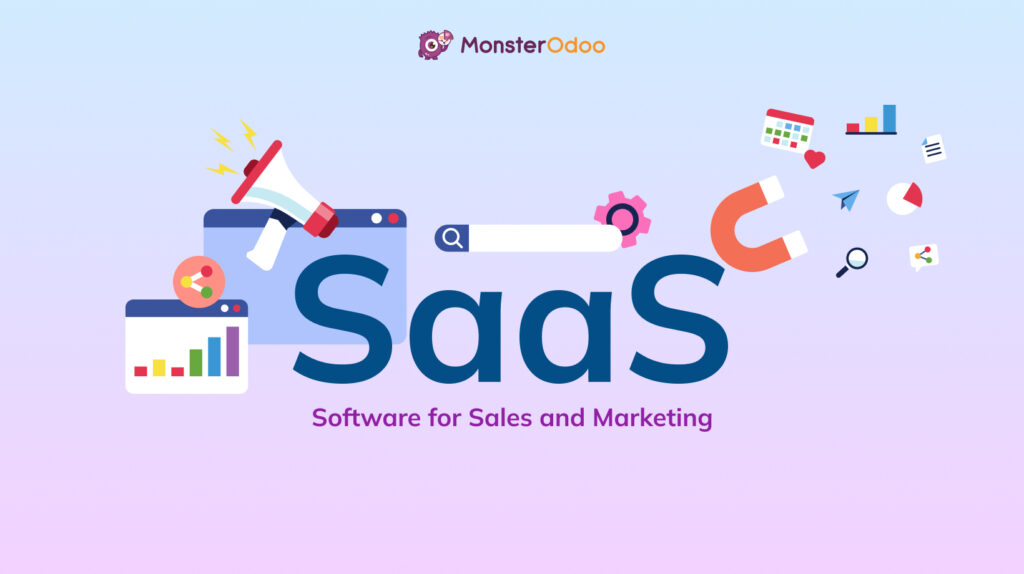In today’s digital era, sales and marketing play a crucial role in the success of businesses. As companies strive to maximize their performance and revenue, the adoption of Software-as-a-Service (SaaS) software has become increasingly prevalent. In this blog post, we will explore how SaaS software can enhance sales and marketing efforts, ultimately driving business growth and profitability.

The Role of SaaS Software in Sales and Marketing:
SaaS software offers a range of capabilities that streamline and optimize sales and marketing processes. Let’s delve into some key areas where software proves invaluable:
- Streamlining Lead Generation and Management: SaaS software automates lead capture and qualification processes, ensuring that businesses can effectively manage and nurture their leads. By centralizing lead data within a SaaS CRM system, sales teams gain a holistic view of prospects, enabling them to prioritize and tailor their engagement strategies.
- Improving Sales Team Efficiency: SaaS software empowers sales teams by streamlining their workflows and providing essential tools for success. Contact management, task automation, and sales pipeline tracking features enable sales representatives to focus on building relationships and closing deals, rather than getting bogged down by administrative tasks.
- Enhancing Marketing Campaigns and ROI: SaaS software offers a range of marketing tools that amplify the impact of marketing campaigns. Email marketing, social media management, and content creation are made more efficient and effective, with the added advantage of data-driven insights and analytics. These insights enable marketers to refine their strategies, optimize their messaging, and achieve a higher return on investment.
Key Features and Benefits of SaaS Software for Sales and Marketing:
SaaS software brings several features and benefits to the table, enabling businesses to achieve sales and marketing excellence:
- Customization and Scalability: SaaS software allows businesses to customize their sales and marketing processes according to their unique needs. Furthermore, as businesses grow and evolve, SaaS solutions can easily scale alongside, accommodating increasing demands and complexities.
- Collaboration and Communication: Effective collaboration between sales and marketing teams is crucial for cohesive and successful campaigns. SaaS software facilitates seamless communication and shared access to resources, fostering collaboration between these departments. This alignment leads to more effective targeting, messaging, and overall campaign success.
- Integration with Third-Party Tools: software offers integrations with other popular sales and marketing tools, providing businesses with a unified ecosystem. These integrations enable data synchronization, streamlined workflows, and enhanced productivity. For example, integrating a SaaS CRM with email marketing software allows for seamless lead nurturing and email campaign management.
Best Practices for Implementing SaaS Software for Sales and Marketing:
To ensure a successful implementation of SaaS software, businesses should consider the following best practices:
Assess Business Needs and Goals:
Before selecting a SaaS solution, it’s crucial to assess your business needs and goals. Identify the pain points and challenges your sales and marketing teams face and determine how SaaS software can address those issues. Consider factors such as lead management, sales process optimization, marketing campaign automation, and analytics requirements. By understanding your specific needs, you can choose the right software that aligns with your objectives.
Plan and Prepare:
Successful implementation of SaaS software requires a well-defined plan and thorough preparation. Start by creating a detailed implementation roadmap that outlines the key milestones, tasks, and timelines. Identify the stakeholders involved and ensure they have a clear understanding of the implementation process. Allocate resources, such as dedicated project managers and IT support, to oversee the implementation and address any technical challenges.
Data migration is another critical aspect to consider during the planning phase. Determine how existing data will be migrated to the new SaaS software and establish a comprehensive data migration strategy. Cleanse and organize your data beforehand to ensure a smooth transition and avoid any data integrity issues.
Training and Onboarding:
Proper training and onboarding are essential for successful user adoption and utilization of the SaaS software. Develop a comprehensive training program to familiarize your sales and marketing teams with the features and functionalities of the software. This can include in-person or virtual training sessions, video tutorials, user guides, and interactive workshops.
Additionally, consider appointing “superusers” within your teams who can serve as internal champions and provide ongoing support and guidance to their colleagues. These superusers can play a crucial role in driving adoption, answering questions, and sharing best practices.
Regular communication and feedback loops are also important during the onboarding process. Encourage your teams to provide feedback on the software’s usability, highlight any pain points or challenges they encounter, and address those concerns promptly. This feedback loop will help refine the implementation process and ensure continuous improvement.
Continuous Evaluation and Optimization:
Implementing SaaS software is not a one-time event but an ongoing process. Continuously evaluate the effectiveness of the software and its impact on your sales and marketing efforts. Regularly assess key performance indicators (KPIs) and metrics to measure the success of the implementation.
Engage with your sales and marketing teams to gather feedback on the software’s usability, features, and overall impact on their productivity. Leverage this feedback to identify areas for improvement and optimization. Stay connected with the SaaS vendor’s support team to address any technical issues, seek guidance on best practices, and explore new features or updates that can further enhance your operations.
Conclusion:
SaaS software has revolutionized the way businesses approach sales and marketing. By streamlining processes, enhancing collaboration, and providing valuable insights, it empowers businesses to boost their performance and revenue. Whether it’s lead management, sales team efficiency, or marketing campaign optimization, leveraging software has become a key differentiator in the modern business landscape. Embrace the power of software for sales and marketing, and pave the way for sustainable growth and success.
If you are interested in implementing SaaS software for your sales and marketing needs, MonsterOdoo can take advantage of our expertise and dedicated support. Please contact us for consultation!



